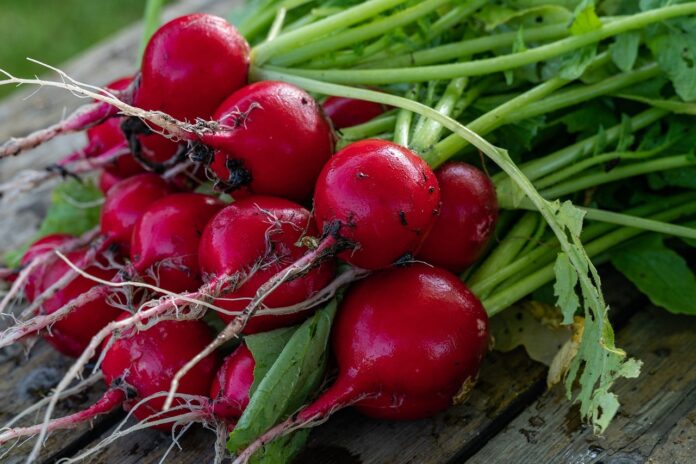The radish (Raphanus sativus) is a root vegetable known for its crisp texture and peppery flavor. It belongs to the Brassicaceae family, which also includes cabbage, broccoli, and kale. Radishes come in various shapes, sizes, and colors, including red, white, pink, purple, and black. They are typically grown as annual crops and thrive in cool climates, making them a staple of spring and fall gardening.
Interesting Facts About The Radish:
- Ancient Cultivation: Radishes are one of the earliest cultivated vegetables, with evidence from 2700 BCE in ancient Egypt, where they were grown alongside onions and garlic. Greeks and Romans also consumed radishes, often with honey and vinegar
- Variety of Shapes and Colors: Radishes come in many forms, from the small round red ones to elongated white daikon varieties, black Spanish radishes, and even vibrant purple or pink types. Each has a unique flavor and culinary use
- Largest Radish on Record: The largest radish ever recorded weighed an astonishing 101 pounds and 1.8 ounces. This giant radish, grown in 2023 by Manda Fermentation Co. in Japan, surpassed the previous record from 2003 by over 30 pounds. It required four people to harvest due to its immense size and was grown using special fertilizers to promote its extraordinary growth
- Rapid Growth: Among the fastest-growing crops, radishes can be ready to harvest in as little as 20–30 days. Some smaller varieties, like Cherry Belle, take even less time, making them perfect for intercropping
- Edible Leaves: Radish greens are not just edible but highly nutritious. They can be sautéed, blended into pesto, or added to soups and stews. They are rich in calcium and vitamin C
- Low in Calories: With only 16 calories per 100 grams, radishes are a guilt-free addition to diets. Their high water content also aids in hydration
- Diuretic Properties: Radishes stimulate the production of urine, helping prevent kidney infections and detoxify the urinary tract
- Good for Diabetics: Radishes have a low glycemic index, meaning they don’t spike blood sugar levels, making them ideal for diabetics
- Respiratory Relief: Compounds in radishes help clear mucus from the respiratory tract, providing relief for conditions like asthma, sinusitis, and bronchitis
- Skin Benefits: The vitamin C, phosphorus, and zinc in radishes contribute to skin health. Radish juice is also used in natural remedies for acne and dryness
- Used in Culinary Delights: Across the globe, radishes are part of traditional dishes, from raw salad additions in Europe to pickled accompaniments in Asia. Their crisp texture and spicy flavor make them versatile
- Mooli Paratha: In Indian cuisine, grated radishes (mooli) are spiced and used as a filling for parathas, a popular flatbread
- Japanese Daikon: The daikon radish is a staple in Japan, known for its mild flavor. It’s used in dishes like miso soup, stir-fries, and pickled sides
- Edible Pods: Varieties like the rat-tailed radish are grown specifically for their seed pods, which have a crunchy texture and a spicy flavor
- Oilseed Radish: This variety is cultivated for its seeds, which are processed into biofuel. It’s also used as a cover crop to enrich soil
- Radish Festivals: The “Night of the Radishes” festival in Oaxaca, Mexico, features carvings from large radishes, showcasing cultural artistry and creativity
- Symbolism: In some cultures, radishes are considered symbols of prosperity and good fortune, often included in traditional rituals and celebrations
- Easily Intercropped: Radishes grow quickly and don’t require much space, making them excellent companion plants. They help deter pests like cucumber beetles
- Historical Utility: In ancient Egypt, radishes were fed to laborers for their nutritional benefits and ability to sustain energy during demanding tasks like pyramid building
- Eco-Friendly Cover Crops: Farmers use radishes to prevent soil erosion, improve aeration, and break up compacted soil, benefiting subsequent crops
- Flavor Profile: The distinct spiciness of radishes comes from compounds like isothiocyanates, which are also found in mustard and horseradish
- Storage Tip: To keep radishes fresh, store them in a refrigerator with their greens removed and place them in water or a damp cloth
- Global Staple: While radishes are often a side salad ingredient in Western diets, in Asia, they play a central role in hearty meals, fermented foods, and soups
